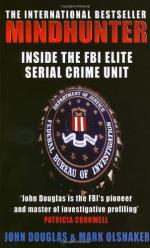
|
| Name: _________________________ | Period: ___________________ |
This test consists of 15 multiple choice questions and 5 short answer questions.
Multiple Choice Questions
1. Where did the Son of Sam stalk his victims?
(a) The post office.
(b) Lover's Lane.
(c) The local bar.
(d) The supermarket.
2. What year did Douglas complete the prison interview study?
(a) 1972.
(b) 1978.
(c) 1983.
(d) 1995.
3. In what year did the ATKID killer attack?
(a) 1962.
(b) 1985.
(c) 1982.
(d) 1979.
4. Who censured Douglas at the start of Wayne Williams' trial?
(a) The FBI.
(b) The Office of Professional Responsibility.
(c) The Office of Professional Conduct.
(d) The Judge.
5. In Chapter 6, to whom did Douglas compare Manson's upbringing?
(a) Kemper's upbringing.
(b) His father's upbringing.
(c) His own.
(d) Bundy's upbringing.
6. What did Douglas compare analyzing a serial killer to in Chapter 6?
(a) Studying a Picasso.
(b) Putting together a puzzle.
(c) A living nightmare.
(d) Watching an art house film.
7. In what city did the ATKID killer strike?
(a) Los Angeles.
(b) New York.
(c) Atlanta.
(d) Memphis.
8. How many cases were in the ATKID killer file?
(a) One.
(b) Sixteen.
(c) Sixty-seven.
(d) Thirty-five.
9. At what time of day did the police interrogate the suspect that abducted and killed a girl in Chapter 10?
(a) Night.
(b) Morning.
(c) All day.
(d) Afternoon.
10. What is the phrase "betting on raindrops rolling down the window" a metaphor for?
(a) Bettors that are afraid to win.
(b) Serial killers that mess up.
(c) Criminals that fail.
(d) Bettors that wager on anything because they love to bet.
11. What was the Trailside Killer's speech impediment?
(a) He was mute.
(b) He stuttered.
(c) He had a lisp.
(d) He could not pronounce his "m's."
12. What did the FBI consider profiling to be prior to 1980?
(a) Time consuming.
(b) A necessary evil.
(c) The future of law enforcement.
(d) Witchcraft.
13. How many victims were interviewed for the prison interview study?
(a) 500.
(b) 118.
(c) 50.
(d) 1,000.
14. What did Douglas wonder about the prison inmates who participated in the interview study at the start of Chapter 7?
(a) Why they would speak to FBI agents openly.
(b) Why they were in prison.
(c) Why they showed no remorse.
(d) How they could be so cruel.
15. Where did road schools teach?
(a) FBI headquarters.
(b) College campuses.
(c) Quantico.
(d) Police stations or academies.
Short Answer Questions
1. Jerry Brudos murdered a girl that accidentally came to his door. What was the profession of the girl?
2. What was Douglas' position in Detroit's Reactive Crimes Unit?
3. In Chapter 3, in what area did Douglas work towards a masters degree?
4. Douglas and Hazelwood believed that the ATKID killer murders were NOT affiliated with which group?
5. Why did Douglas decide that Russell Odom and Clay Lawson were not criminally insane?
|
This section contains 450 words (approx. 2 pages at 300 words per page) |

|




